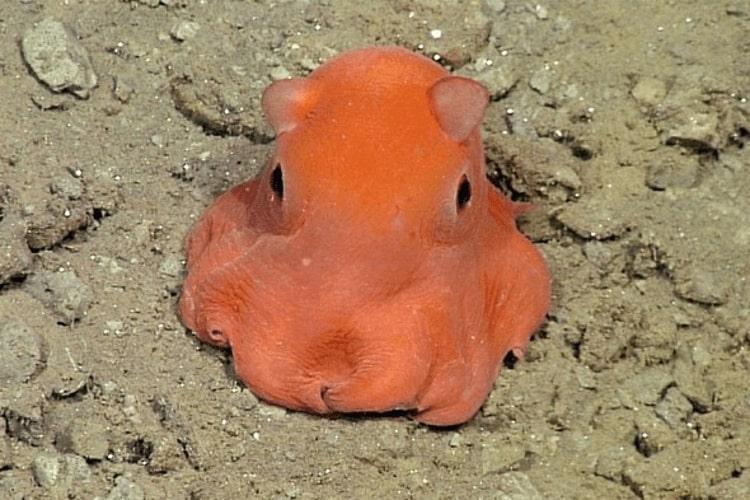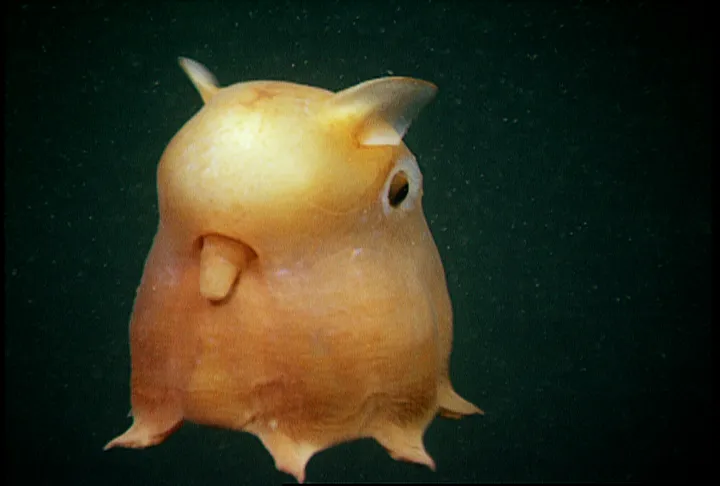Meet the Dumbo Octopus: The Deep Sea’s Most Adorable Mystery
Way down in the darkest corners of the ocean, beyond where sunlight dares to reach, lives a creature that looks like it could’ve leapt out of a Disney film: the Dumbo octopus. Named after the classic flying elephant because of its round head and big, flappy ear-like fins, this small yet fascinating marine invertebrate is an example of nature at its quirkiest. But beyond its cartoonish appearance lies a complex animal with remarkable adaptations for surviving in the crushing depths of the sea.
In this in-depth guide, we’ll explore surprising and often overlooked facts about the Dumbo octopus, cutting through the deep-sea mystery to bring you the best up-to-date insights. Whether you’re a marine biology enthusiast, a student, or just someone secretly obsessed with ocean creatures (we see you), prepare to dive deep into what makes this octopus unlike any other.

1. What Exactly Is a Dumbo Octopus?
“Dumbo octopus” isn’t just one species, but an entire genus known scientifically as Grimpoteuthis. Scientists currently recognize at least 15 official species within this genus, each adapted to extreme ocean depths. Though often grouped together under one cute name, these animals display a variety of visual features and coloration depending on their individual species and habitat.
Unlike shallow-water octopuses you might find near coral reefs, Grimpoteuthis belongs to a suborder known as Cirrina, characterized by:
- Internal shells that provide body support
- Small fin-like structures that resemble elephant ears
- Fleshy webbing that connects their arms, giving a “parachute” effect
These features make them distinct from more well-known octopus species and uniquely equipped to survive the deep sea’s incredible pressure and cold temperatures.
2. Living Deep: The Dumbo Octopus Habitat
Most Dumbo octopuses live 3,000 to 7,000 meters below the surface of the ocean, and some have been recorded as deep as 7,000 meters (23,000 feet)—a record for any known octopus species. This zone is known as the bathyal to hadal regions, where oxygen is scarce, temperatures are near freezing, and sunlight is non-existent.
They’ve been discovered all over the world, from the icy waters near Antarctica to the tropical depths of the western Pacific. Notable locations include:
- The Monterey Canyon (California coastline)
- Mariana Trench (the deepest ocean trench on Earth)
- Indian Ocean near hydrothermal vents
Dumbo octopuses are one of the rare few cephalopods that spend their entire lives in the deep — never coming close to the surface.
3. Not Your Average Cephalopod
While most octopus species use jet propulsion to swim, Dumbo octopuses prefer a gentler approach. Their “ear” fins flap slowly, propelling them gracefully through the water like open-sea ballet dancers. They can also pulse their mantle or use their arms to crawl along the seafloor when needed.
Other unique traits of the Dumbo octopus include:
| Characteristic | Dumbo Octopus | Typical Shallow-Water Octopus |
|---|---|---|
| Skeleton | Internal, cartilaginous shell | No skeleton |
| Locomotion | Flapping fins and pulsing | Jet propulsion and crawling |
| Habitat | 3000–7000 meters deep | 0–200 meters typically |
| Arm Webbing | Connected with fleshy webbing | Usually separate arms |
4. What Do Dumbo Octopuses Eat?
At those depths, a trip to the local reef buffet isn’t an option. Dumbo octopuses are predatory and feed primarily on small pelagic animals such as:
- Brine shrimp and other small crustaceans
- Worms (polychaetes)
- Amphipods
- Copepods and isopods
Thanks to their adaptability, Dumbo octopuses swallow food whole using their beak. They don’t break food apart like some octopuses do — an energy-efficient approach for a low-nutrient environment.
5. Reproduction Without the Rush
One of the most surprising behaviors of dumbo octopuses is their reproductive strategy. Unlike some cephalopods that mate seasonally or die shortly after reproduction, females of the genus Grimpoteuthis produce eggs continuously.
Fun fact: In 2005, scientists discovered a female Dumbo octopus carrying multiple eggs in different stages of development – suggesting she could reproduce anytime, whenever conditions are favorable [NOAA].
Males transfer spermatophores (sperm packets), and females then store and fertilize eggs internally when ready. The eggs themselves are large and yolk-rich, indicating that newly hatched offspring are fairly developed and capable of surviving solo immediately — a must in a world where survival depends on independence from Day 1.

6. Can They Change Colors?
Unlike their shallow-water cousins who expertly use chromatophores (pigment cells) to change colors rapidly, Dumbo octopuses don’t display this flashy behavior as much. Since they live in near-total darkness, visual camouflage isn’t as useful.
However, some deep-sea species do exhibit subtle changes in hue depending on their environment and mood — mostly in shades of reddish-brown, blue, or milky white. Researchers have also observed glow-in-the-dark bioluminescent patches in certain species, but these are rare and under investigation.
7. Recent Discoveries & Ongoing Research
Until recently, our knowledge of Dumbo octopuses was spotty, consisting of deep-sea trawling specimens and short ROV footage. But new oceanic expeditions and deep-diving submersibles are turning up more data than ever.
- In 2016, researchers aboard the NOAA Okeanos Explorer captured some of the clearest footage of a Dumbo octopus at 12,000 feet.
- In 2021, scientists from Germany’s GEOMAR Helmholtz Centre for Ocean Research found evidence suggesting Dumbo octopuses could be indicators of deep-sea ecosystem health.
- Recent phylogenetic studies show Dumbo octopuses may have ancient evolutionary links with both deep and midwater cephalopods [Molecular Biology and Evolution].
More and more we’re learning: Dumbo octopuses aren’t just curiosities. They could play a critical role in understanding how life adapted to Earth’s most extreme conditions.
8. Are They Endangered?
Currently, Dumbo octopuses are not considered endangered. Their deep-sea habitat makes them relatively safe from human interference, but not immune. The biggest future threats include:
- Deep-sea mining: Growing interest in harvesting rare-earth metals from the seafloor may disturb their habitat.
- Climate change: Changes in ocean temperature and acidity may disrupt food chains in the deep sea.
- Ghost fishing gear: Lost fishing nets and debris can drift down and become hazards in the deep.
Because they are still so mysterious, conservation efforts are limited. But as technology improves and risks increase, they may soon be front-and-center in deep-ocean preservation discussions.
9. How Big Are Dumbo Octopuses?
Despite their deep-water home and eerie mystique, Dumbo octopuses are typically small. The average size ranges from 20 to 30 centimeters (8 to 12 inches), but some species can grow as large as 1.8 meters (6 feet) long!
Weight often remains unknown due to sampling difficulties, especially since pressure changes can damage recovered specimens. Nonetheless, their compact size and squishy, gelatin-like bodies make them incredibly energy-efficient travelers in the deep sea.
Related Questions You Might Be Wondering
Do Dumbo Octopuses have brains?
Yes, and they’re pretty clever. Like all cephalopods, Dumbo octopuses have a centralized brain and a complex nervous system. While their brains may not be as developed in terms of learning and play behaviors as those of some shallow-water octopuses, they likely possess impressive problem-solving skills suited for tracking prey in the dark ocean.
Can I see a Dumbo Octopus in an aquarium?
Unfortunately, no. Due to the extreme pressure and temperature requirements of their deep-sea environment, Dumbo octopuses cannot survive in captivity. Their physiology is so uniquely adapted to high-pressure habitats that even brief exposure to surface conditions can be fatal.
Why are they called Dumbo Octopuses?
The name “Dumbo” refers to the prominent ear-like fins protruding from the tops of their heads, which resemble the ears of Disney’s Dumbo the flying elephant. The resemblance, alongside their gentle movements, has made the nickname popular among marine enthusiasts.
How do Dumbo octopuses avoid predators?
Though not much is known due to the lack of direct observation, it’s believed they rely on stealth and the vastness of the deep sea rather than complex defensive behaviors. The surrounding darkness is an ally; few predators roam that deep. Their gelatinous, neutrally buoyant bodies may also reduce energy output that would draw attention.
We’ve Only Scratched the Surface
The Dumbo octopus is one of the ocean’s best-kept secrets, a soft, bubbly ambassador from the abyssal zone that defies everything we think we know about life. With their mesmerizing movements, unique biology, and extreme habitat, Dumbo octopuses remind us of how little we truly understand about the deep ocean, which covers over 60% of Earth’s surface.
As technology improves and ocean exploration continues, we can only hope more of their hidden behaviors and roles in the marine ecosystem will come to light. Until then, the Dumbo octopus will remain equal parts mystery and marvel, an unforgettable figure in the underwater world.
